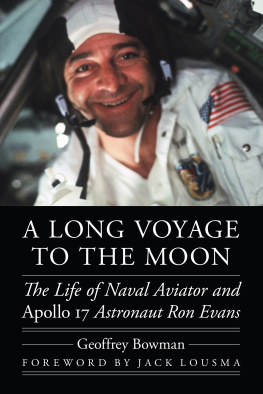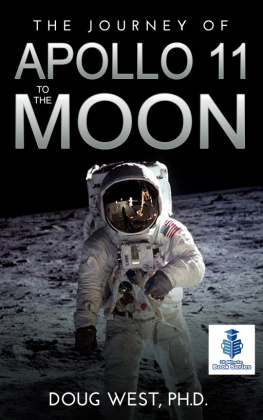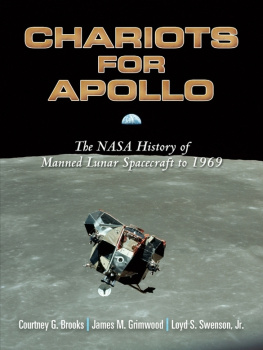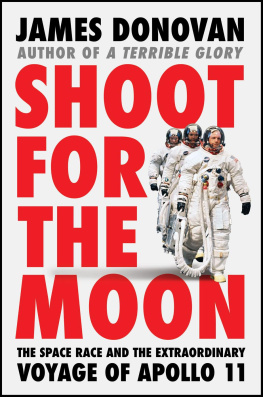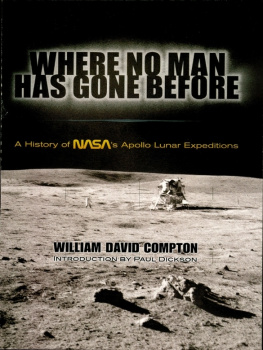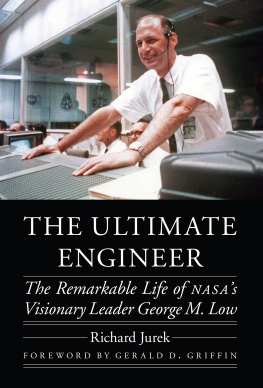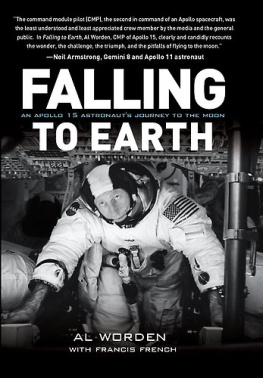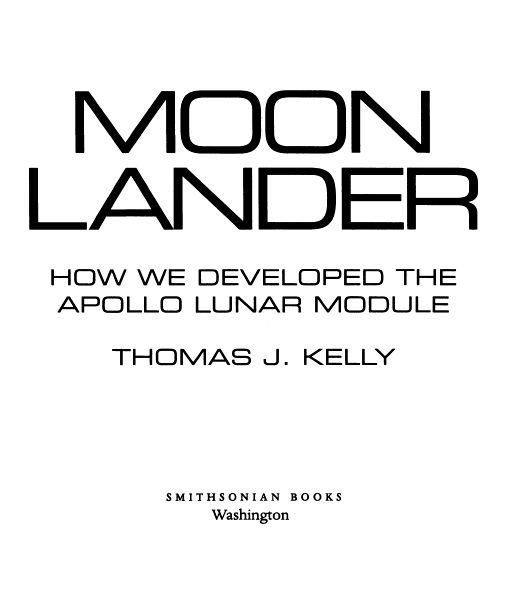Smithsonian History of Aviation and Spaceflight Series
Dominick A. Pisano and Allan A. Needell, Series Editors
Since the Wright brothers first flight, air and space technologies have been central in creating the modern world. Aviation and spaceflight have transformed our livesour conceptions of time and distance, our daily routines, and the conduct of exploration, business, and war. The Smithsonian History of Aviation and Spaceflight Series publishes substantive works that further our understanding of these transformations in their social, cultural, political, and military contexts.
2001 by Thomas J. Kelly
All rights reserved
Copy editor: Karin Kaufman
Production editor: Robert A. Poarch
Designer: Chris Hotvedt
Library of Congress Cataloging-in-Publication Data
Kelly, Thomas J., 1929
Moon lander: how we developed the Apollo lunar module / Thomas J. Kelly.
p. cm. (Smithsonian history of aviation and spaceflight series)
Includes bibliographical references and index.
ISBN 978-1-58834-273-7
1. Lunar excursion module. 2. Project Apollo (U.S.). I. Title. II. Series.
TL795.K45 2001
629.44dc21 00-063728
British Library Cataloguing-in-Publication Data is available
This is an electronic release (eISBN: 978-1-58834-361-1) of the original cloth edition
For permission to reproduce illustrations appearing in this book, please correspond directly with the owners of the works, as listed in the individual captions. Smithsonian Books does not retain reproduction rights for these illustrations individually or maintain a file of addresses for photo sources.
www.smithsonianbooks.com
v3.1_r1
To Joan, whose loving support made my lunar adventure possible.
Contents
Illustrations
Lunar module proposal design
Reaction control system configuration
Lunar modules ascent stage
Lunar modules crew compartment
Lunar modules descent stage
Final lunar module design
NASA officials view lunar module mockup
Tom Kelly in his office, 1965
Lunar modules weight history
Mated lunar module in final assembly
Micrometeorite and thermal shields
Tom Kelly and Dick McLaughlin at LM-1 delivery
Supporting Apollo 11 in the Spacecraft; Analysis Room
Celebrating the Apollo 11 Moon landing
Acronyms
| Acronym | Full Name | Definition |
| ACE | Automated checkout equipment | Computerized system for testing spacecraft |
| AEA | Abort electronics assembly | Computer used in AGS |
| AGS | Abort guidance system | Backup guidance and control in LM |
| AIAA | American Institute of Aeronautics | Aerospace engineering professional society and Astronautics |
| ALSEP | Apollo lunar surface experiments | Experiments deployed on the lunar surface package |
| AMPTF | Apollo Mission Planning Task | Prepared mission plans (time lines) and the Force design reference mission |
| APS | Ascent propulsion system | Ascent rocket engine and tanks |
| ASA | Abort sensor assembly | Inertial reference sensors for AGS |
| ASDTP | Apollo Spacecraft Development Test Plan | Overall program test plan |
| ASPO | Apollo Spacecraft Program Office | NASA-Houston program management group for the Apollo spacecraft |
| ATCA | Attitude and translation control | Flight-maneuver hand controllers assembly |
| BAFO | Best and final offer | Contractors last offer in competition |
| CARR | Customer Acceptance Readiness Review | Formal review authorizing spacecraft delivery to NASA |
| CDR | Critical Design Review | Approval of detailed design |
| CM | Command module | Launch and reentry spacecraft |
| CRT | Cathode ray tube | Monitor for computer processed data |
| CSM | Command/service modules | CM and SM mated |
| DECA | Descent engine control assembly | Descent-engine controller |
| DEDA | Data entry and display assembly | AGS data entry keyboard |
| DFI | Development flight instrumentation | Added measurements for engineering data |
| DOD | Department of Defense | U.S. Department of Defense |
| DPS | Descent propulsion system | Descent rocket motor and tanks |
| DR | Discrepancy report | Chits written against problems during reviews and flights |
| DRM | Design reference mission | Typical mission plan and time line to establish design requirements |
| ECS | Environmental control system | Oxygen and thermal control |
| EMI | Electromagnetic interference | Unintended electrical or magnetic signal distortion |
| EO | Engineering order | Documentation authorizing drawing changes |
| EOR | Earth-orbit rendezvous | Mission mode with two Earth launches and rendezvous and assembly in Earth orbit |
| EPS | Electrical power system | Batteries and power distribution |
| ETRB | Executive and Technical Review Board | Corporate oversight board for LM |
| EVA | Extravehicular activity | Spacewalks outside the spacecraft |
| FITH | Fire in the hole | Igniting LM ascent engine atop the descent stage |
| FTA | Flammability test article | Boilerplate LM cabin for flammability tests |
| GNC | Guidance, navigation, and control | Guidance and attitude system control |
| ICD | Interface control document | Drawings/specifications defining interfaces between spacecraft |
| IFM | In-flight maintenance | Component replacement in flight |
| ISS | International Space Station | Large space station produced by NASA and an international team |
| KSC | Kennedy Space Center | Launch site at Cape Canaveral, Florida |
| L/D | Lift-to-drag ratio | Index of aerodynamic maneuvering capability |
| LEM | Lunar excursion module | NASAs early name for the lunar module |
| LES | Launch escape system | Escape rocket atop CM at launch |
| LGC | LM guidance computer | Computer for LM guidance and control |
| LM | Lunar module | Lunar landing spacecraft |
| LMP | LM mission programmer | Special programmer for controlling unmanned LM flight |
| LMS | LM mission simulator | Ground-based LM flight simulator |
| LOR | Lunar-orbit rendezvous | Mission mode in which LM rendezvous with CM in lunar orbit |
| LRV | Lunar roving vehicle | Electric-powered car used on later missions |
| LTA | LM test article | Full-scale, partially equipped LM for special tests |
| LTM | LM test model | Reduced-scale test model LM or components |
| MCC | Mission Control Center | Room in NASA-Houston where the flight director and controllers directed flight missions |
|
Next page

